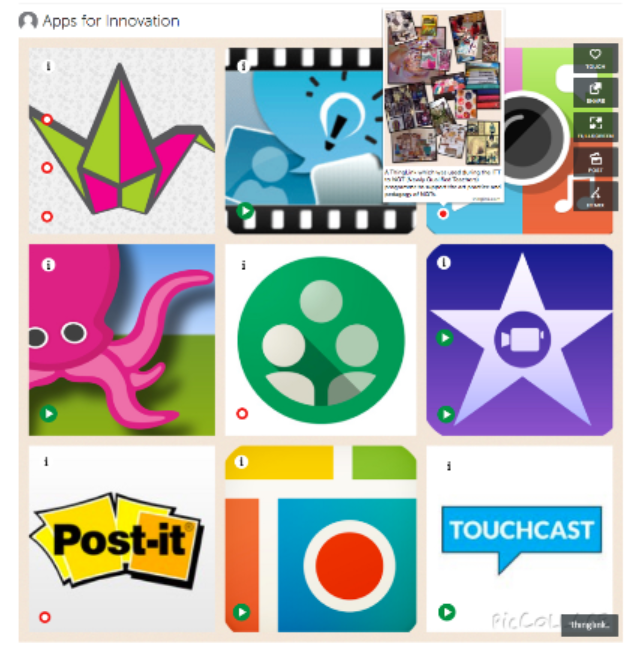TEL Communities
|
TEL Communities Definitions: Theoretical background relevant to technology facilitated social learning Research evidence: Systematic literature reviews on the theme of technology facilitated social learning |
Example 6: Mobiles in Higher EducationCommunity URL: https://plus.google.com/u/0/communities/110218249780833007111 Blog URL: http://mypad.northampton.ac.uk/appsforinnovation/ The Apps for Innovation Group is a group of lecturers in Initial Teacher Training piloting the use of iPads for teaching and learning at the University of Northampton. They used F2F meetings, a blog and a G+ community. Learning intentions: · To document and support the use of iPads by academic staff within the School of Education at the University of Northampton over the course of an academic year and provide a platform for sharing expertise more widely. · To provide a Google+ (G+) space for academic staff to ask questions, share resources and ideas, and reflect on their practice during the implementation of the iPads project. Overview: The G+ community and blog aimed to document the rollout of the use of iPads by academic staff in their teaching and learning. The project provided support for novice users who were able to seek advice from their peers, who shared what worked for them, until they gained sufficient confidence to experiment for themselves. New skills developed, supported by a collaborative team with a common purpose that tested and shared strategies and resources. Learning Outcomes Knowledge continued to be transferred between novices and experts within the group outside of face-to-face meetings via the G+ community discussions. Over time, a core set of open-ended content-creation apps emerged as users trialled them for different purposes and recorded successes as mini case studies on the blog. The group provides an example of collective knowledge-building around a common purpose. Project summary As the group solved problems together, sought help from each other, reused solutions and evaluated new apps, they developed a ‘collective competence’ and a shared repertoire of resources and strategies. A core set of apps for content creation evolved over the course of the year, with tools being reused to meet a range of learning objectives across different subject areas within the group. A shared consensus emerged that apps such as these can help make students’ learning more visible. Knowledge continued to be transferred between novices and experts within the group outside of face-to-face meetings via the G+ community discussions. Cross-pollination of ideas occurred as apps for art activities bringing together the ‘app smashing’ combination of Rollworld, Fragment and BeFunky, which has been independently explored by three academics and has resulted in several related posts and a series of comments on the blog and community. The blog and online community together provided a structured framework in which social learning could take place (Wenger, 2011). It can be seen as a connectivist learning environment in which participants make connections with people and resources, co-create ideas and make choices within an environment mediated by technology (Saadatmand and Kumpulainen, 2014; Downes, 2010; Siemens, 2005); "Connectivist models explicitly rely on the ubiquity of networked connections between people, digital artefacts, and content" (Anderson and Dron, 2011, p. 87). A benefit of online learning is identified here; learning opportunities are multiplied as the collective learning potential of the group exceeds that of the individual working on their own and can thus lead to accelerated learning (Richardson, 2010; Hung, 2002). Johnson highlights this as a key idea when saying, “The learning that evolved from these communities is collaborative, in which the collaborative knowledge of the community is greater than any individual knowledge” (Johnson, 2001, p34). (Source: Caldwell and Heaton, 2016) Summary of benefits
Technology enables fluid learning journeys across a combination of locations, times, online spaces and social settings in higher education. Source: Caldwell, H. and Heaton, R., 2016. The interdisciplinary use of blogs and online communities in teacher education. The International Journal of Information and Learning Technology, 33(3), pp.142-158. Available at: The interdisciplinary use of blogs and online communities in teacher education References: Anderson, T. & Dron, J. (2011). Three generations of distance education pedagogy. The International Review of Research in Open and Distance Learning, 12.3, 81-97. Retrieved from http://www.irrodl.org/index.php/irrodl/article/view/890/1663 Deng, L., and Yuen, A. H. (2011). Towards a framework for educational affordances of blogs. Computers and Education, 56(2), 441-451. Downes, S. (2010). What is democracy in education? [Web blog post]. Retrieved from http://halfanhour.blogspot.com/2010/10/what-is-democracy-in-education.html Farmer, B., Yue, A., and Brooks, C. (2008). Using blogging for higher order learning in large cohort university teaching: A case study. Australasian Journal of Educational Technology, 24(2), 123-136. Gannon-Leary, P. & Fontainha, E. (2007). Communities of Practice and virtual learning communities: benefits, barriers and success factors. Barriers and Success Factors. eLearning Papers, 5. Gunawardena, C. Hermans, M. Sanchez, D. Richmond, C. Bohley, M. & Tuttle, R. (2009). A theoretical framework for building online communities of practice with social networking tools. Educational Media International, 46.1, 3-16. Heaton, R. (2014). Moving mindsets: Re-conceptualising the place of visual culture as multi-sensory culture in primary art education. Canadian Review of Art Education, 41.1, 77-96. Hung, D. (2002). Situated cognition and problem-based learning: implications for learning and instruction with technology. Journal of Interactive Learning Research, 13.4, 393-415. Lave, J. & Wenger, E. (1991). Situated learning: Legitimate peripheral participation. Cambridge: Cambridge university press. Mason, R. & Rennie, F. (2008). Social networking as an educational tool. E-learning and social networking handbook: Resources for higher education, 1-24. Richardson, W. (2010). Blogs, wikis, podcasts and other powerful web tools for classrooms. Thousand Oaks, CA: Corwin. Saadatmand, M. & Kumpulainen, K. (2014). Participants' perceptions of learning and networking in connectivist MOOCs. MERLOT Journal of Online Learning and Teaching, 10.1, 16-30. Siemens, G. (2005). Connectivism: A learning theory for the digital age. International Journal of Instructional Technology and Distance Learning, 2.1, 3-10. Retrieved from http://www.itdl.org/Journal/Jan_05/article01.htm Wenger, E. White, N. & Smith, J. D. (2009). Digital habitats: Stewarding technology for communities. Portland: CPsquare. Wenger, E. (2011). Communities of Practice: A brief introduction. Retrieved from: https://scholarsbank.uoregon.edu/xmlui/handle/1794/11736 Yang, S. H. (2009). Using blogs to enhance critical reflection and community of practice. Educational Technology and Society, 12.2, 11-21
|



